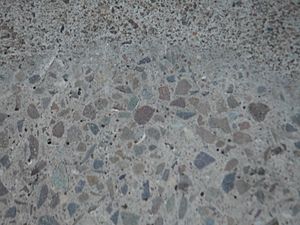Aggregate (composite) facts for kids
Aggregate is a special kind of material used in building things. Think of it as the "filler" or "backbone" of many construction materials. It's usually made of small pieces of rock, sand, or gravel. When you mix aggregate with other materials, like cement and water to make concrete, it helps the final product be strong and hold its shape.
Aggregate is very important because it helps materials resist being squashed or crushed. It also makes the material bigger without costing too much. For example, when you make concrete, you use different sizes of aggregate, from tiny grains of sand to larger pieces of gravel. This mix of sizes helps fill all the spaces, making the concrete very strong and solid.
Contents
What is Aggregate?
Aggregate is a key ingredient in many building projects. It's a collection of loose materials like sand, gravel, crushed stone, or even recycled concrete. These pieces are mixed with a binding material, like cement, to create a strong, solid product. Imagine building a wall with just glue; it wouldn't be very strong. But if you mix the glue with lots of small stones, it becomes much tougher!
Why Do We Use Aggregate?
Aggregate plays several important roles in construction.
- Strength: It helps materials like concrete become very strong. The aggregate pieces resist pressure, making the whole structure much harder to break.
- Bulk: It adds volume to the material. This means you can make a large amount of concrete or asphalt without using too much of the more expensive binding materials.
- Stability: It helps keep things stable. For example, in roads, aggregate layers provide a firm base that can support heavy traffic.
- Cost-Effective: Using aggregate is often cheaper than using only cement or other binding materials. This helps keep construction costs down.
Where Does Aggregate Come From?
Aggregate can come from different places and be made in various ways.
- Natural Aggregates: Most aggregate comes from natural sources. This includes sand and gravel found in riverbeds or old lakebeds. Crushed stone is another common type, made by breaking down larger rocks like granite, limestone, or basalt in quarries.
- Recycled Aggregates: To be more eco-friendly, we can also use recycled materials as aggregate. For example, old concrete from demolished buildings can be crushed and reused. This helps reduce waste and saves natural resources.
How is Aggregate Used?
Aggregate is used in many different ways in our daily lives, even if you don't always see it.
- In Concrete: This is one of the most common uses. Concrete is a mix of cement, water, and aggregate (sand and gravel). It's used for foundations, buildings, bridges, and sidewalks.
- In Roads: The layers under asphalt roads are often made of different types of aggregate. These layers provide drainage and a strong base for the road surface.
- In Railroads: The loose stones you see under train tracks are also a type of aggregate. They help support the tracks and allow water to drain away.
- In Drainage Systems: Aggregate is used in drainage systems to help water flow away from buildings or roads, preventing flooding.
Aggregate might seem like just a bunch of rocks, but it's a fundamental part of how we build our world!
See also
 In Spanish: Árido (minería) para niños
In Spanish: Árido (minería) para niños


